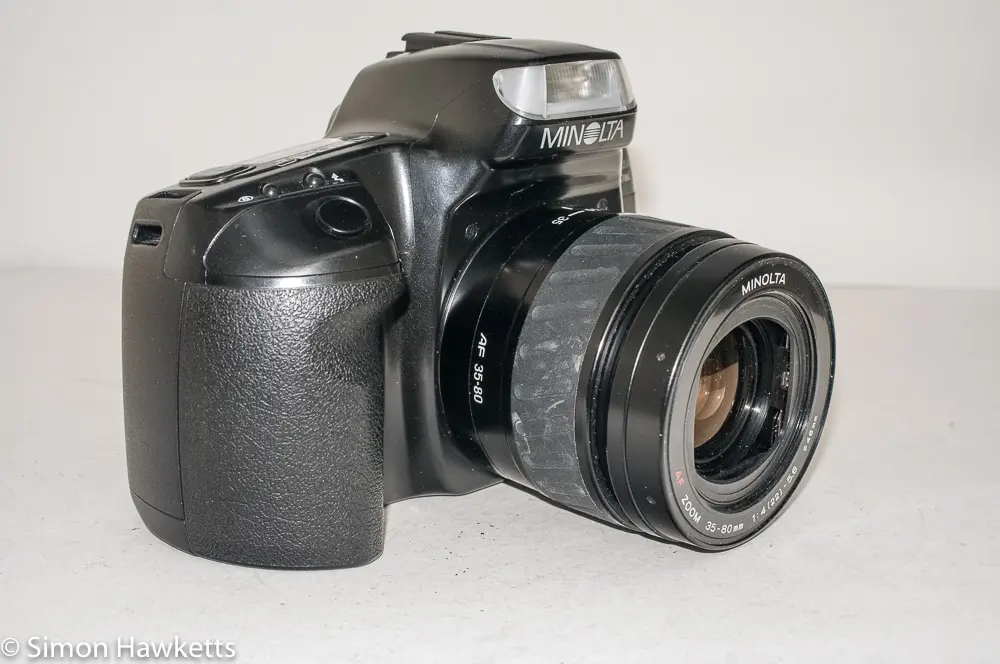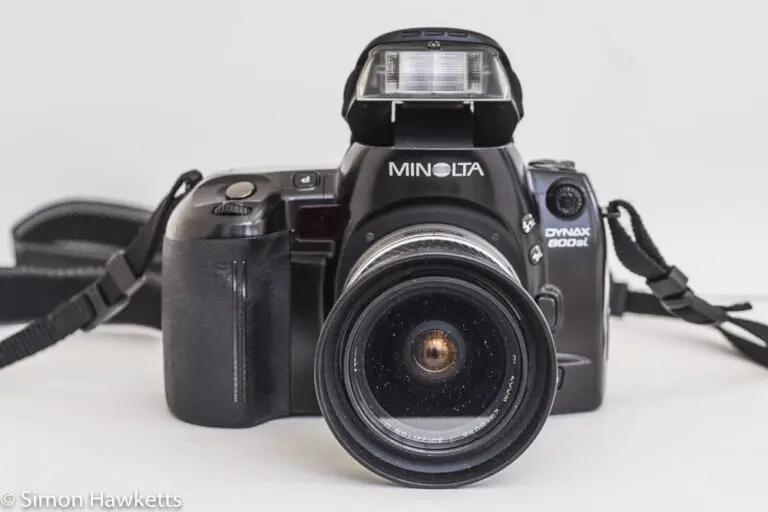Minolta Dynax 300si 35 mm SLR Camera
The Minolta Dynax 300si 35 mm autofocus SLR was the entry level camera in the Minolta si series, which culminated in the 800si. Although it didn’t have many of the pro-level features of that camera, it was still a capable unit for family and holiday snapshots, as well as a good camera for anyone intending to grow into the more capable Minolta autofocus offerings.
Minolta Dynax 300si Images








My Minolta Dynax 300si Camera
I picked up my copy of the 300si when I bought a whole box of 7 different Minolta Dynax camera bodies for £25 and this was one of the included units. The cameras I was most interested in were the Dynax 7xi and the Dynax 700si, but there was also a 505si and this 300si as well.
In common with all the cameras in the box, the 300si was in top condition with hardly a mark on the body and all the controls and electronics working a treat as soon as I put a battery in it. None of the cameras came with lenses, but I have several Minolta autofocus zoom lenses, and for the purposes of the pictures above I fitted a 35 to 80 mm f/4 autofocus lens to the camera.
Minolta Dynax 300si Description
As I said above, the 300si was the entry point into the Minolta Dynax xxxsi range of 35 mm autofocus cameras. As such, it designed to be made at a cheaper price point than some of the more fully featured units in the series, which were aimed at more serious photographers.
For example, the lens mount on this camera is a plastic affair rather than the metal mount on the 700si and 800si units. In fact, the whole camera makes extensive use of plastic in its construction, but I have to say doesn’t feel flimsy or lightweight as a result. All the exterior panels are solid and don’t flex when gripped or twisted at all. In fact, one item which is a common failure point in cameras – the pop-up flash – is certainly stronger by being visible and available at all times.

Being an entry level camera means there wasn’t too much effort put into features like multiple exposure modes and information displays. There is a single exposure mode which is basically ‘Auto everything’ or Program mode, but to help the photographer deal with multiple different ‘snapshot’ situations there are variations of the program which can be selected as scene modes. The camera allows the photographer to select Portrait, Landscape, Macro, Sports mode and Night time modes which basically determine which aperture / shutter combination to choose when multiple options are available. For example, in Landscape mode the camera will choose the smallest aperture it can to increase depth of field, in portrait mode it will do the opposite to try to blur the background etc.
In the viewfinder there is a very simple display which just consists of the actual ground glass screen to view and compose the picture (which is fairly dull with an f/4 lens fitted and a mirror rather than prism) with the focus point in the centre and then 4 LEDs down the left-hand side. One of these LEDs indicate that the focus system is actually in the process of focusing, and another indicates that focus has been achieved. A third indicates that the flash is charged and ready to use, and finally there is an LED to show that the focus is switched on. Although this is a limited set of information, the one plus point, which applies to all full frame cameras, is that the view screen is very big compared to a modern APS-C camera.
The other indicator available on the camera is the LCD on the top panel and this contains information about any scene mode selected, flash status, frame number, drive mode, self-timer etc. Being an entry level camera, this LCD doesn’t light up, but for the majority of the users the camera is aimed at that probably didn’t matter much.

The control layout is fairly conventional, with an on/off switch on the top left-hand side along with a button to change the drive mode. On the right-hand side is the LCD panel along with a mode button to select the scene mode or program mode. Above the LCD are a couple of buttons for flash mode and red-eye reduction, and at the front of the top panel is the shutter release. The only other button is for the autofocus / manual focus, which is on the front of the camera at the bottom, underneath the lens release. Oh, and on the actual bottom of the camera is a recessed button to allow the film to be rewound if required (the film will automatically load and rewind, so this is for ’emergencies’).
Although this is an entry level camera without too many features, the series it belongs to was a top set of cameras capable of fantastic results and I suspect that for the things that matter like metering and exposure, for the majority of users it would still give excellent results.
Minolta Dynax 300si Specifications
- Minolta Dynax 300si 35mm autofocus SLR camera
- Electronic shutter with speeds from 1/2000 to 30 sec
- 8 segment pattern metering
- Program mode auto exposure + 5 scene modes
- Built in flash with Red Eye reduction function and guide number 12 @100 ISO
- Auto/Manual focus selection
- Auto focus with single central focus sensor
- Focus lock when in autofocus mode
- DX coded without override. Speed 25 to 5000
- Single / Continuous frame drive mode
- Self timer
- Wireless flash capability
- Flash doubles as focus assist light
- Auto film load and Auto film advance
- Single 2CR5 battery required for operation
- Handbook available on-line here
Discover more from Everything Vintage
Subscribe to get the latest posts sent to your email.



